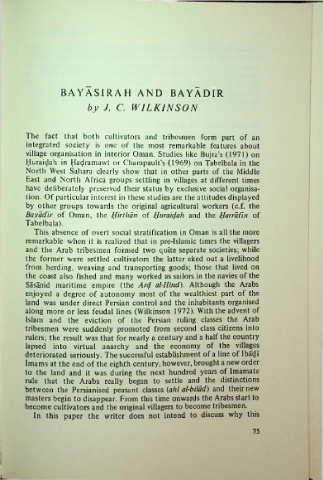Page 89 - Arabian Studies (I)
P. 89
BAYAS1RAH AND BAYADIR
by J. C. WILKINSON
The fact that both cultivators and tribesmen form part of an
integrated society is one of the most remarkable features about
village organisation in interior Oman. Studies like Bujra’s (1971) on
Huraidah in Hadramawt or Champault’s (1969) on Tabelbala in the
North West Sahara clearly show that in other parts of the Middle
East and North Africa groups settling in villages at different times
have deliberately preserved their status by exclusive social organisa
tion. Of particular interest in these studies are the attitudes displayed
by other groups towards the original agricultural workers (c.f. the
Bayadir of Oman, the Hirthan of Huraidah and the Harrafin of
Tabelbala).
This absence of overt social stratification in Oman is all the more
remarkable when it is realized that in pre-Islamic times the villagers
and the Arab tribesmen formed two quite separate societies; while
the former were settled cultivators the latter eked out a livelihood
from herding, weaving and transporting goods; those that lived on
the coast also fished and many worked as sailors in the navies of the
Sasanid maritime empire (the Ard al-Hind). Although the Arabs
enjoyed a degree of autonomy most of the wealthiest part of the
land was under direct Persian control and the inhabitants organised
along more or less feudal lines (Wilkinson 1972). With the advent of
Islam and the eviction of the Persian ruling classes the Arab
tribesmen were suddenly promoted from second class citizens into
rulers; the result was that for nearly a century and a half the country
lapsed into virtual anarchy and the economy of the villages
deteriorated seriously. The successful establishment of a line of Ibadi
Imams at the end of the eighth century, however, brought a new order
to the land and it was during the next hundred years of Imamate
rule that the Arabs really began to settle and the distinctions
between the Persianised peasant classes (ahl al-bilad) and their new
masters begin to disappear. From this time onwards the Arabs start to
become cultivators and the original villagers to become tribesmen.
In this paper the writer does not intend to discuss why this
75

